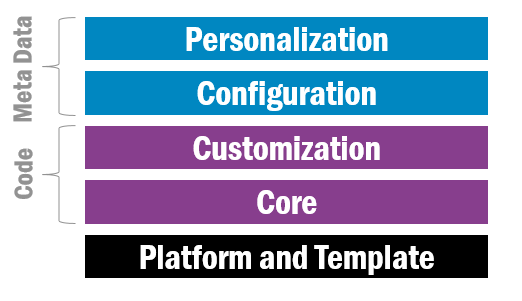Layered Application Architecture¶
Layered Application Architecture (LAA) addresses separation of concerns and separation of ownership, in code layers and configuration layers.
LAA enables the possibility to extend and customize IFS Cloud code non-intrusively, reducing future Total Cost of Ownership of IFS Cloud.,
Layer definitions¶
IFS Cloud has a layered application architecture consisting of five layers of different types:

- Personalization layer - where users can personalize the user experience of IFS Cloud. The personalization is typically performed by end users themselves and stored in the user’s personal user profile, but can also be prepared by super users and distributed through the users base profile.
- Configuration layer - where the solution owners configure or tailor the IFS Applications solution to fit the specific work processes and routines of the using organization. Configurations done in this layer are typically stored in configuration table sin the database. Configuration includes custom fields, events, menus, pages and more.
- Customization code layer - the code layer where any customizations are written.
- Core code layer - the main code layers containing the code for the R&D standard IFS Cloud release.
- Technical Platform layer - this layer enables the layers above. Technical platform is not layered in itself.
Changes in the personalization and configuration layer can take effect immediately as the changes are made. However, often configuration changes go through a staging step where the changes are first prepared and then “published” to take affect for all users. Neither of these require system restart.
Changes in code layers require an applications build, delivery, and deployment to take place. The deployment may require system restart.